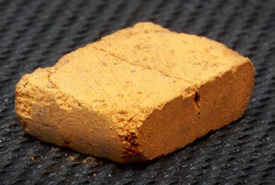
“Should we ever get human settlers on Mars, they’ll likely have to construct their buildings at least partially out of Martian soil. That said, it would be nice if they didn’t have to bring along a bunch of kilns, in order to fire that soil into bricks. Well, according to a NASA-funded study conducted at the University of California San Diego, Martian bricks can actually be made without any heat whatsoever.
Led by Prof. Yu Qiao, the UCSD team was initially trying to make bricks by mixing simulated Martian soil with binding polymers. What the scientists discovered, however, was that the polymers weren’t even necessary if the simulant was subjected to a high enough pressure.
In order to make that happen, the material was first placed in a flexible rubber tube. That tube was then compacted at a pressure equivalent to “someone dropping a 10-lb [4.5-kg] hammer from a height of one meter [3.3 ft].” This resulted in round soil pallets, which were subsequently cut into bricks.
When tested, those bricks were found to be stronger than steel-reinforced concrete.”
More at the source: New Atlas.com
Thanks to long time reader Chris for this story.

I don’t care about Martian or lunar construction–though Khalili took his superadobe to NASA ;)
To me, after they quoted this Martian brick as stronger than reinforced concrete, the most interesting paragraph in this article is:
“It is believed that the secret to the bricks’ success lies in the tiny iron oxide particles which coat the larger basalt particles that make up the simulant. When pressed together, the clean, flat facets of the iron particles bind to one another, thus also binding the basalt particles together.”
Pretty interesting take on aggregate and binders…
And I have typically separated both my basalt (exterior reinforcement) and my iron oxide (minimal rust jacking conditions on interior – for cost savings)…
It reminds me of ferrock, another newer synthesized Portland alternative, I believe, an iron / iron oxide and co2 —>iron carbonate product that also supposedly outperforms Portland binders in many mechanical properties.
I’m all for traditional earthen methods where appropriate. But I’m also for masonry where appropriate, smarter masonry even more so. The EUs estimated carbon footprint for Portland is probably more accurate than the American statistic (the figure must be backed concrete industry association)
Although Germany is killing it with preform aircrete panels. Check YouTube.
Yes to finding better building materials on earth. I’ll check out the preform aircrete panels.
Radiation. According to research papers published by NASA and others, there are two major types of radiation affecting people and their equipment going into space and to Mars. The first is radiation from the Sun, and the second some different radiation coming from outside the Solar System. These mean firstly that people have to shield themselves within the space craft during the trip, far more than for instance on the ISS. Secondly when actually on Mars, then it will be a case of remaining shielded for most of the time, and briefly going out on the surface. One quotation is of going up to the surface from a deep underground base, for three hours every three days. The idea of building a structure on the surface of Mars using bricks, and freely living inside it, is just not one that ties in with published work on the internet from NASA and others about radiation on the planet. Or am I missing something obvious ?
I doubt if humans will spend much time if any on Mars for decades. These fanciful stories are mostly trying to raise funding for space projects.
It was a little funny when they almost made it sound like they had discovered rammed earth.
Search our blog for related stories on green brick/sustainable brick. There are lots of alternatives. Sadly though most are very slow coming to market.